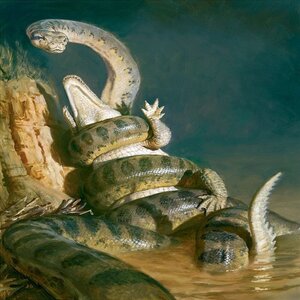
Titanoboa
CBUB Wins: 0
CBUB Losses: 0
CBUB Ties: 0
Win Percentage: 0%
Added by: Mercenaryblade
Read more about Titanoboa at: Wikipedia
Official Site: Public Domain
Titanoboa ( ) is an extinct genus of very large snake that lived in what is now La Guajira in northeastern Colombia. They could grow up to , perhaps even long and reach a weight of . This snake lived during the Middle to Late Paleocene epoch, around 60 to 58 million years ago following the extinction of the dinosaurs. Although originally thought to be an apex predator, the discovery of skull bones revealed that it was more than likely specialized in preying on fish. The only known species is Titanoboa cerrejonensis, the largest snake ever discovered,
In 2009, the fossils of 30 individuals of T. cerrejonensis were found in the Cerrejón Formation of the coal mines of Cerrejón in La Guajira, Colombia. These specimens consist of the holotype, a large precloacal vertebrae, the paratype, also a vertebrae, and 184 additional remains identified as additional vertebrae and ribs (some of which found in articulation), amounting to a total of 28 specimens in addition to the holotype and paratype. Before this discovery, few fossils of Paleocene-epoch vertebrate had been found in ancient tropical environments of South America. The snake was discovered on an expedition by a team of international scientists led by Jonathan Bloch, a University of Florida vertebrate paleontologist, and Carlos Jaramillo, a paleobotanist from the Smithsonian Tropical Research Institute in Panama. Field work continued following these initial discoveries, recovering multiple additional specimens including three skulls with associated postcranial bones.
The scientific name combines the Greek word "Titan" with Boa, the type genus of the family Boidae. The species name on the other hand is a reference to the Cerrejón region.
Most material of Titanoboa consists of vertebrae that in life would be located before the cloaca. They are robust with a uniquely T-shaped neural spine. The skull is only briefly described in a 2013 abstract. According to it, Titanoboa is unique in the high amount of palatal and marginal tooth positions compared to others boids, the quadrate bone is oriented at a low angle and the articulation of both the palatine to pterygoid and pterygoid to quadrate are heavily reduced. The teeth themselves are weakly ankylosed, meaning they are not strongly connected to the jawbone.
CBUB Match Record:
No Regular Play Records Available
No Fantasy Draft Records Available
